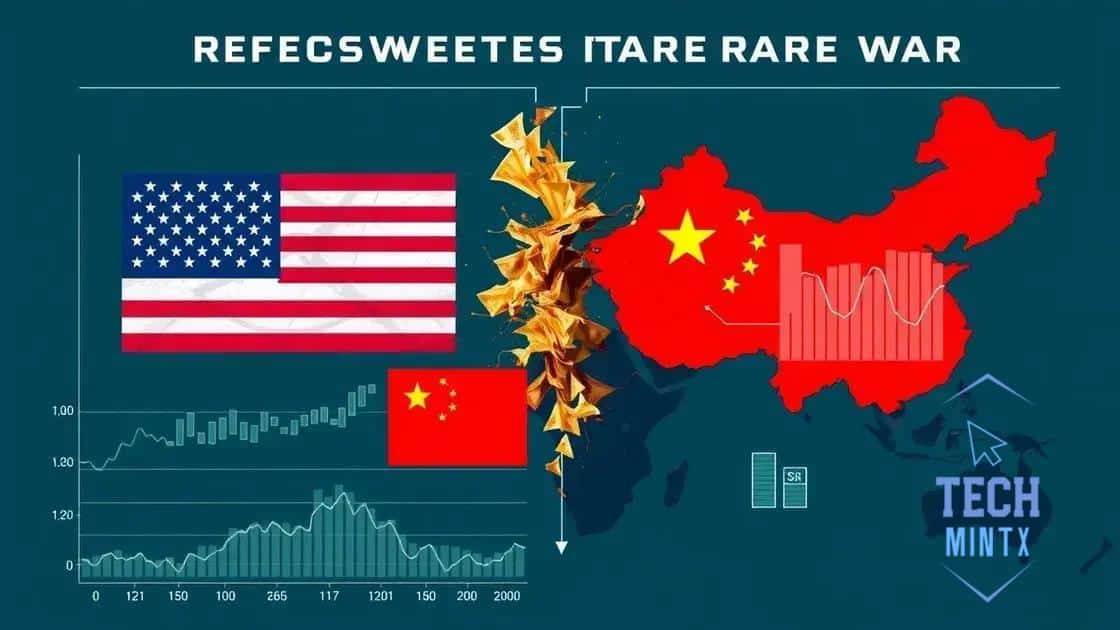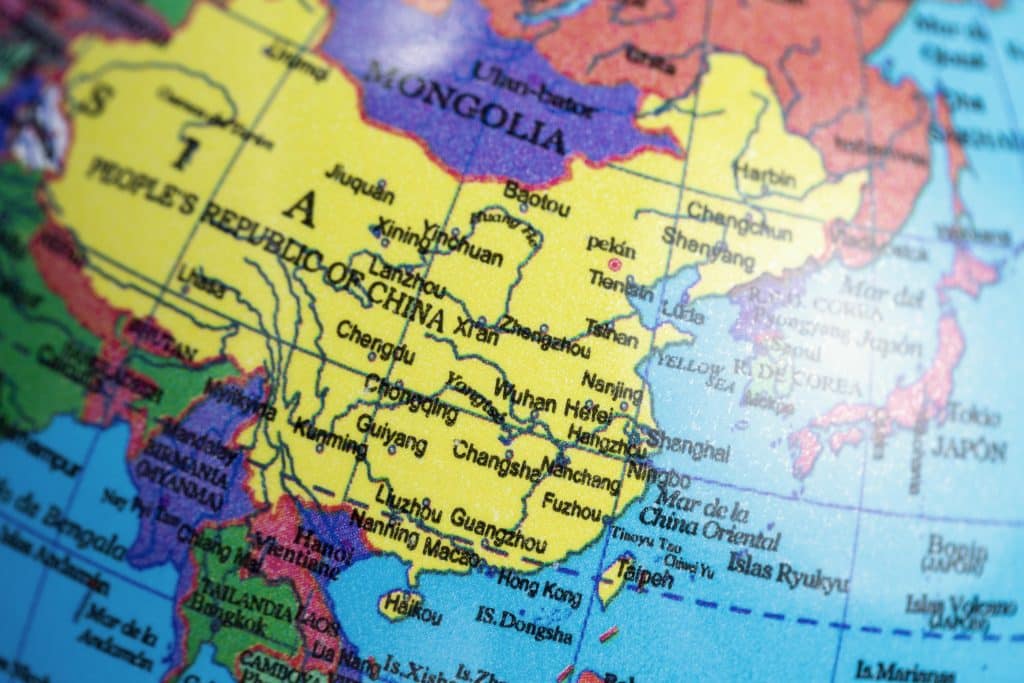Financial repercussions of the US-China trade conflict

The financial repercussions of the US-China trade conflict include increased consumer prices, disruptions in supply chains, and the necessity for businesses to adapt through diversification and technology investment.
The financial repercussions of the US-China trade conflict are shaping not only the economies of both countries but also impacting global market dynamics. Have you noticed rising prices in your favorite products? This article dives into the intricate effects of this ongoing conflict.
Understanding the US-China trade conflict
Understanding the US-China trade conflict is essential to grasp the larger economic implications that affect the global market. This conflict originated from trade imbalances, tariffs, and political tensions between these two economic giants. It has significant repercussions on various sectors, influencing everything from manufacturing to consumer behavior.
Key causes of the trade conflict
The trade conflict can be traced back to several key issues:
- Trade deficits: The United States has a significant trade deficit with China, leading to concerns over unfair trade practices.
- Intellectual property theft: The US alleges that China engages in intellectual property theft, which undermines American companies.
- Tariffs: The implementation of tariffs has created a cycle of retaliation, escalating tensions further.
These factors contribute to a complex situation where both nations are trying to protect their economic interests while navigating the global marketplace.
Impact on global supply chains
The US-China trade conflict has also reshaped global supply chains. Many companies are reconsidering where to manufacture their products. Some are moving facilities to other countries to avoid tariffs, while others are investing in technology to increase efficiency.
This shift affects the cost of goods available to consumers. As manufacturers move production, consumers may see higher prices for certain products, while others may experience shortages. Companies are faced with tough decisions that can have long-term effects on their operations.
As the conflict continues, it’s important to understand how it impacts not just the US and China, but also the interconnected global economy.
Key economic impacts on global markets

The key economic impacts on global markets stemming from the US-China trade conflict are profound and far-reaching. As both countries impose tariffs and restrictions, the effects ripple through economies across the globe. Investors, manufacturers, and consumers are all feeling the consequences of this contentious relationship.
Market volatility and investor reactions
One immediate impact is the increase in market volatility. Investors often react swiftly to news related to the trade conflict. Changes in tariffs can lead to:
- Fluctuations in stock prices: As companies report gains or losses due to tariffs, their stock values can rapidly change.
- Currency fluctuations: The value of currencies, like the US dollar and the Chinese yuan, can shift based on trade news.
- Changes in investment flows: Investors may redirect their funds to safer markets when uncertainty rises.
These reactions contribute to a climate of uncertainty that can hinder economic growth.
Effects on global supply chains
The trade conflict has also affected global supply chains significantly. Companies relying on materials and products from China face higher costs due to tariffs. This situation can lead to:
- Increased production costs: Manufacturers may pass these costs onto consumers, raising prices.
- Shifts in sourcing: Businesses might seek alternative suppliers to mitigate risks associated with the trade conflict.
- Disruptions in delivery times: As companies scramble to adjust, delays can occur, affecting logistics.
Consequently, consumers may notice higher prices for various goods and longer wait times for products.
Another key impact is the slowdown in global economic growth. As the trade conflict escalates, countries may experience reduced exports and imports, which decreases overall economic activity. For example, industries that rely heavily on exports to China may see a decline as demand decreases. Additionally, the uncertainty surrounding trade policies can discourage businesses from investing in expansion or new projects.
Effects on consumer prices and supply chains
The effects on consumer prices and supply chains due to the US-China trade conflict are significant and far-reaching. As tariffs are imposed and trade relations become strained, many products are becoming more expensive for consumers. This isn’t just about higher prices; it’s also about how businesses operate and where products come from.
Increased costs for consumers
One of the most visible effects is the rise in consumer prices. Tariffs on imported goods can lead to:
- Higher retail prices: When companies face increased costs, they often pass these costs onto consumers.
- Reduced variety of products: Some companies may choose to stop importing certain items, leading to fewer options for consumers.
- Quality concerns: To maintain lower prices, some businesses might reduce the quality of their products.
These changes can directly impact household budgets, forcing families to spend more on essentials.
Disruptions in supply chains
Along with rising costs, the trade conflict has created disruptions in global supply chains. Businesses that rely on materials and components from China face uncertainty and challenges. This can result in:
- Delay in product availability: As companies adjust their supply chains, delays in product delivery can occur.
- Shifts in sourcing: Many businesses are exploring suppliers outside of China to reduce dependency.
- Increased logistics costs: The need to find alternative routes can lead to higher transportation expenses.
Such disruptions can result in longer wait times for consumers and may lead to stock shortages in certain markets. The unpredictability of the trade conflict continues to challenge how businesses manage their supply chains, affecting not only companies but also their customers.
Long-term repercussions for US and China

The long-term repercussions for the US and China due to the ongoing trade conflict are complex and may reshape their economic landscapes for years to come. As the situation evolves, both countries are likely to face significant changes in trade relationships, business practices, and overall economic growth.
Shifts in economic power
One major consequence is the potential shift in economic power. As tariffs drive up costs, companies may start moving operations out of China to avoid these fees. This can lead to:
- Increased manufacturing in other countries: Companies might seek alternatives in places like Vietnam or India.
- A decline in China’s manufacturing dominance: As businesses leave, it may affect China’s status as the world’s factory.
- Growth opportunities for emerging markets: Countries looking to attract foreign investment may benefit.
Such shifts can alter global supply dynamics and create new leaders in manufacturing.
Changes in consumer patterns
As prices rise due to tariffs, consumer habits might change as well. People may become more selective about their purchases, turning to:
- Budget-friendly alternatives: Consumers might choose lower-cost options over premium goods.
- Local products: There may be a greater push for domestically made goods as a means to support local economies.
- Second-hand markets: Used products could gain popularity as consumers look to save money.
These shifts can influence businesses to adapt their marketing strategies and product offerings.
The long-term trade conflict may also foster greater innovation within the US and China. Companies may invest more in technology to improve efficiency and lower costs in response to heightened competition. This drive for innovation can lead to new products and services, benefiting both economies in the long run.
Strategies for businesses to adapt
Strategies for businesses to adapt to the ongoing US-China trade conflict are crucial for maintaining competitiveness and profitability. As trade relations fluctuate, companies must find ways to navigate the challenges presented by tariffs and shifting consumer demands.
Diversifying supply chains
One key strategy is diversifying supply chains. By sourcing materials and products from multiple countries, businesses can reduce the risks associated with geopolitical tensions. This approach allows companies to maintain a constant flow of goods even if one source is disrupted:
- Use local suppliers: Partnering with domestic manufacturers can mitigate shipping delays and tariffs.
- Explore new markets: Identify suppliers in emerging markets to gain cost advantages.
- Strengthen relationships: Building solid partnerships with a variety of suppliers can ensure reliability.
These steps not only help ease supply chain disruptions but also provide a buffer against price increases.
Investing in technology
Another effective strategy is investing in technology to enhance operational efficiency. By adopting advanced technologies, businesses can streamline processes and cut costs. This investment might look like:
- Automation: Implementing robotic processes can reduce labor costs and increase speed.
- Data analytics: Using data to understand consumer trends can help companies adjust their offerings effectively.
- Inventory management systems: These tools can optimize stock levels and reduce waste caused by overproduction.
These technological improvements can provide a competitive edge in a volatile market.
Lastly, businesses should remain agile and responsive to changes in the market. Being flexible allows companies to pivot quickly in response to policy changes or consumer behaviors influenced by the trade conflict. This adaptability can position businesses favorably as new opportunities arise.
FAQ – Frequently Asked Questions about the US-China Trade Conflict
What are the main causes of the US-China trade conflict?
The main causes include trade deficits, tariffs imposed on goods, and issues related to intellectual property rights.
How does the trade conflict affect consumer prices?
Increased tariffs can lead to higher prices for goods, as companies often pass cost increases onto consumers.
What strategies can businesses use to adapt to the trade conflict?
Businesses can diversify their supply chains, invest in technology, and stay flexible to respond to changes in the market.
What are the long-term effects of this trade conflict?
Long-term effects may include shifts in economic power, changes in consumer behavior, and accelerated innovation in businesses.





